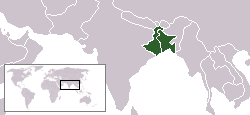A Tale of Two Bengals
Someone could be a native of Bengal, speak only Bengali, and yet not be from Bangladesh. In fact, today this describes over 80 million people. Here’s how this happened.
In the beginning there was Bengal, the primarily low-lying area formed by the delta of the Ganges, the largest river delta in the world. Most of the land is within 30 feet of sea level, and the mostly uninhabitable southern portion, the Sundarbans, is dangerous marshy jungle. In addition to the usual snakes, crocodiles, and other predators big and small, the Sundarbans is still home to the feared Royal Bengal Tiger, which to this day kills an average of one person every three days–typically the seasonal honey collectors that live and work at the edges of the lush mangrove forests.
There are recorded settlements in the fertile rice-producing lands of Bengal dating back at least 4,300 years, but it was the 12th century conquest of the land by Muslim Mughal forces that would directly shape its future. The Mughals, whose powerful legacy in India include the Persian-inspired architecture of the Taj Mahal, introduced Islam to the Hindu lands of Bengal, and therein lay the seeds of Bengal’s eventual 20th century split.
By 1947, British India was both on the verge of independence and civil war. Religious tensions between Hindus and Muslims were at an all-time high, included civil unrest, riots and violence, and many on both sides were calling for a partition of the country along religious lines. One notable exception to this school of thinking was Gandhi, who stated:
“My whole soul rebels against the idea that Hinduism and Islam represent two antagonistic cultures and doctrines. To assent to such a doctrine is for me a denial of God.”
Nevertheless, Gandhi’s voice was in the minority, and British India in 1947 was indeed split along religious lines (Gandhi’s assassin shortly thereafter was a Hindu nationalist who believed that Gandhi had appeased Muslims at the expense of Hindus.)
Thus was born Pakistan. If you look at a map of the world today, you will see that Pakistan is to the northwest of India. But at the time of the partition, the large Indian province of Bengal to the east was also cleaved in half. The western half became the Indian province of West Bengal, which continues to this day with Calcutta as its regional capital.
The eastern half of Bengal, separated from Pakistan by over a thousand miles, became Eastern Pakistan. As I mentioned in a previous post, Eastern Pakistan seceded from Pakistan in 1971 and is now Bangladesh.
The religious partition of India into India and Pakistan was not entirely easy nor peaceful. It is estimated that some 7 million Hindis moved from Pakistan to India within months of the partition, and likewise that 7 million Muslims moved to Pakistan from India, with mutual violence and slaughter causing upwards of a million deaths.
Today, the ancient state of Bengal is still cut in two. Bengalis share a common culture, history, language and tradition that dates back thousands of years, but religion has cleaved them apart. India’s West Bengal state is 73% Hindu and 25% Muslim, whereas East Bengal, or the country of Bangladesh, is 90% Muslim and 9% Hindu. Relations between the two countries are friendly, as it was India that helped Bangladesh gain independence from Pakistan, but these are now two peoples on different paths.
So this is the tale of the two Bengalis. For the most part, all Bangladeshis are Bengalis, but not all Bengalis are Bangladeshis.

 Click to subscribe via RSS feed
Click to subscribe via RSS feed

Thanks for the most helpful history lesson!
History. Very informative.
You wrote quite a lot of historical (e.g. A Tale of Two Bengals) and cultural information of countries you visited. Are these extracted from history books? or internet? nationals of a specific country?
Thanks. I’ve found that it helps my own appreciation of the places I visit to get a better historical understanding of what shaped them to their present day.
Usually I look at a combination of guide books, the internet, the discussions I’ve had with local people, and random tidbits floating around in my brain. Drinking chai helps dislodge the latter. 😉
Chai with rum? 😉
It’s great to have all the tidbits stitched together into one lively, coherent and digestible story.
Fascinating history. It takes effort to compile such article. Thank you for sharing.